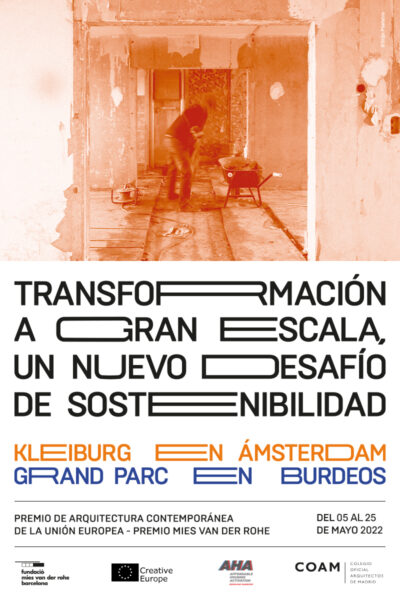
The exhibition puts into dialogue two of the most relevant examples of the transformation of housing blocks built in the 60s and 70s in Europe, winners of the European Union Prize for Contemporary Architecture – Mies van der Rohe Award.
The exhibition puts into dialogue two of the most relevant examples of the transformation of housing blocks built in the 60s and 70s in Europe, winners of the European Union Prize for Contemporary Architecture – Mies van der Rohe Award.
Based on these examples, presented through photographs, texts, models and videos, other projects with similar characteristics that were demolished are related by means of a timeline. Other examples of collective housing built more recently are presented with models and two texts, one by Francis Rambeft and the other by Josep Maria Montaner and Zaida Muxí, serve to introduce the theme and follow the narrative thread of the exhibition.
As Josep Maria Montaner and Zaida Muxí write, “In general, emblematic examples of large-scale collective housing complexes are studied at the time they were designed, built and inaugurated, but very little has been studied and written about how each of these buildings evolved and adapted, to find out what their legacy really was. Houses are for living, and their maintenance and adaptability is essential. Therefore, the key to progress lies in how and what we can learn from experience.
Modern collective housing is living heritage, so it is important to know its transformations and appropriations; to understand what have been the qualities of construction and remodelling facilities”. Based on this reflection, the exhibition allows us to debate about these housing blocks that are found in most European cities, how to deal with them in order to improve the living conditions of their inhabitants, and at the same time to do so by looking at examples of new collective housing blocks built in recent years.
The exhibition shows two exemplary projects for their transformation with the aim of improving the quality of life of their inhabitants, taking each of them into account. It also provides a framework in which to address specific proposals on access to housing, based on concrete examples that can be copied, adapting them to the specific contexts of each place.
Three years ago, the renovation of one of the largest apartment buildings in the Netherlands, called Kleiburg, received the European Union Prize for Contemporary Architecture – Mies van der Rohe Award 2017. The Prize had never been won by a collective housing project until then. Just a year ago, a different group of jury members decided to award the 2019 Prize to the transformation of three social housing blocks in Bordeaux.
In both cases, the existing buildings belonged to the massive construction wave that occurred in the 1960s in European cities. They are two successful survivors who escaped the wrecking ball. In the exhibition, these two protagonists illustrate how strategic and sensible transformations are the alternative to demolition.
Projects included in the exhibition:
- DeFiat Kleiburg, Amsterdam, XVW architectuur; NL Architects
- Transformation of 530 dwellings – Grand Pare Bordeaux, Bordeaux, Lacaton & Vassal architectes; Frédéric Druot Architecture; Christophe Hutin Architeeture
- Housing on Giudecca, Giudecca, Valle Architetti Associati
- Friedrichstadt Housing Block, Berlin, Aldo Rossi
- Rue de Meaux Housing Complex, Paris, Renzo Piano Building Workshop
- Residential Housing KNSM-Eiland, Amsterdam, Prof. Kollhoff Generalplanungs-GmbH Shipboy Housing, Helsinki, Helin & Co Architects
- Borneo Sporenburg, Amsterdam, West 8 urban design & landscape architecture b.v. Hagen lsland, Amsterdam, MVRDV
- Chassé Park Apartments, Breda, Xaveer De Geyter Architects Schots 1 and 2, Groningen, 8333 Architecture + Urbanism Silodam, Amsterdam, MVRDV
- VM Housing Complex, Copenhagen, BIG – Bjarke lngels Group. JOS Architects
- The Mountain, Copenhagen, BIG – Bjarke lngels Group. JDS Architects
- Herold Social Housing, Paris, Jakob+Macfarlane
- 8 House, Copenhagen, BIG – Bjarke lngels Group.
- Timberyard Social Housing, Dublin, O’Donnell + Tuomey
- Tour Bois-le-Pretre Housing Block, Paris, Frédéric Druot Architecture. Lacaton & Vassal architectes
- NAVEZ – 5 social units, Schaarbeek, MSA 1 V+
- Ely Court, London, Alisan Brooks Architects
- Collective housing for etderly people, Barcelona, peris+toral.arquitectes; Bonell i Gil Puukuokka Housing Block (house 1), Jyvaskyla, OOPEAA Office for Peripheral Architecture
- Performative Brise- Soleil, Vienna, StudioVIayStreeruwitz ZT-GMBH Residential and studio building, Berlin, ifau; HEIDE & VON BECKERATH